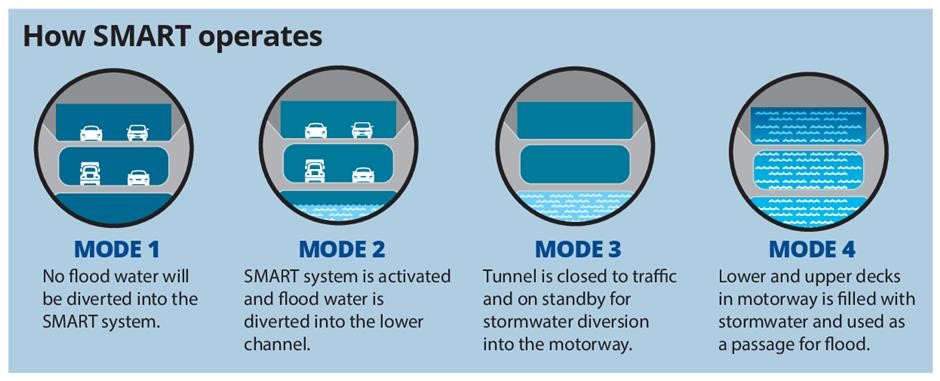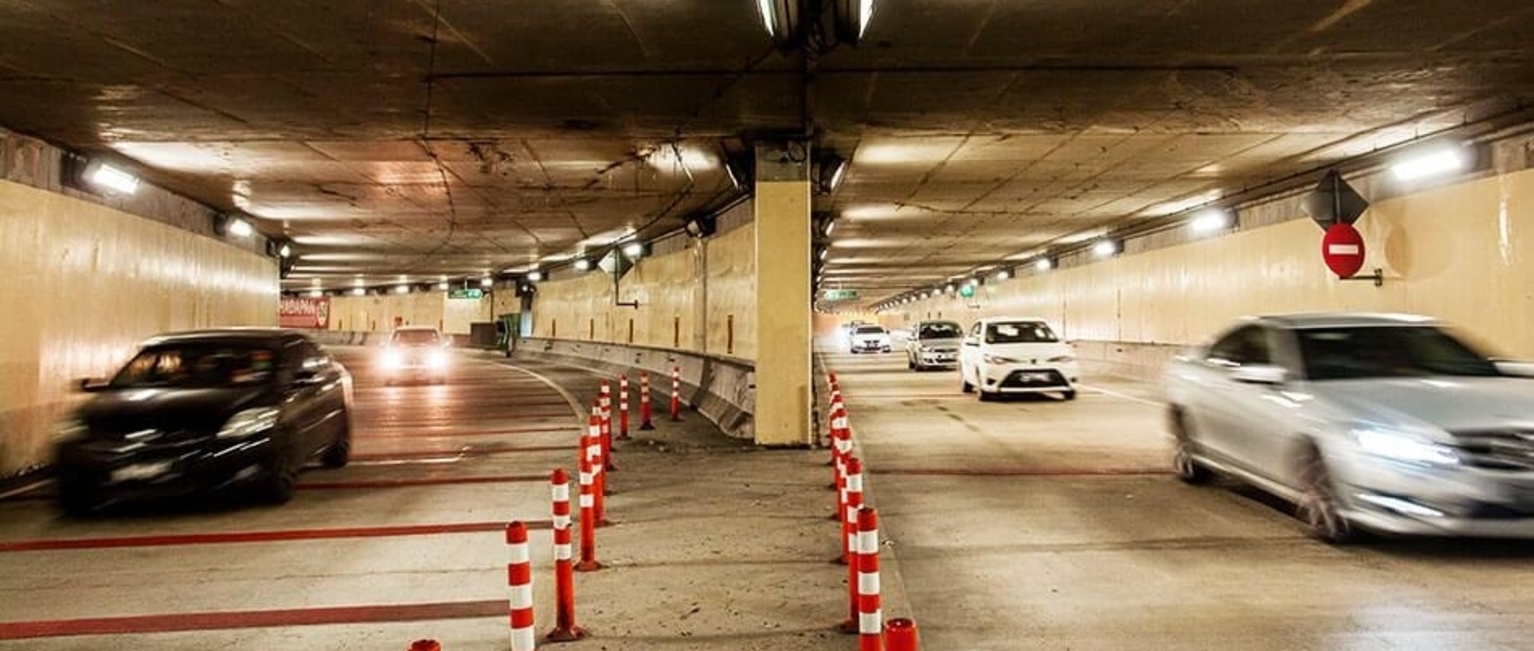Kuala Lumpur’s Stormwater Management and Road Tunnel’s (SMART) innovative design has consistently served the needs of flood-prone and traffic-heavy Kuala Lumpur.
Construction started in 2003 to build the country’s longest and most technologically advanced tunnel. Opening in 2007, the 13.2m diameter tunnel consists of a 9.7km stormwater bypass tunnel, with a 3km dual-deck motorway within it.
SMART’s functions both to control flooding, especially flash floods, and as a motorway.
The tunnel was commissioned after an earlier study identified the flood-prone stretch of river between the Sungai Klang/Sungai Ampang confluence and the Sungai Gombak/Sungai Klang confluence. The river is further constrained by the low Jalan Tun Perak Bridge, leading to a situation where heavy storms can rapidly create floods, severely affecting city centre areas around Masjid Jamek, Lebuh Ampang, Dataran Merdeka and Chinatown.
A capital on a flood plain
Under normal dry conditions or low rainfall, the tunnel remains in Mode 1, helping to ease KL’s rush hour traffic by offering an alternative route linking the Kampung Pandan roundabout to the KL-Seremban Highway, cutting driving times from 15 minutes to seven minutes. Currently more than 30,000 vehicles use the tunnel daily.
The SMART tunnel has three ways for dealing with heavy rainfall. A moderate storm activates the Mode 2 where floodwater is diverted into the bypass tunnel in the lower channel of the motorway tunnel, while the upper levels remains open to motorists.
If the storm worsens, Mode 3 is activated. The tunnel is closed to traffic, and on standby in case floodwaters have to be diverted through the traffic decks.
Mode 4 is initiated when excess floodwaters need to be channelled into the upper and lower traffic tunnel compartment. Automatic watertight gates are opened to allow floodwater to pass through.
This multi-modal water diversion system controls rising waters via a holding pond, bypass tunnel and storage reservoir, thus reducing the floodwater levels at the Jalan Tun Perak Bridge and preventing spill-over into the city.
As of 2018, Mode Two has been activated more than 200 times, while Mode Four incidents have occurred seven times.

In operation for over 12 years now, the SMART tunnel mitigates 45 percent of the total flood risks in the Klang Valley, and its activation has saved the city from gridlock and possibly more serious disaster.
For example, in just one weekend’s deluge last year, the tunnel successfully accommodated and diverted 3.5 million cubic metres of water, closing to traffic for only 10 hours despite continuous rainfall on Friday and Saturday.
The excess flood water at the confluence of the Klang River and Ampang River upstream was diverted and channelled into the holding pond at Kampung Berembang temporarily. It was then directed to the Taman Desa pond downstream via the 9.7km SMART tunnel that acts like a river, before being released back into the Kerayong River near the Taman Desa pond.
Accommodating a growing city
The SMART tunnel has won many accolades through the years, including receiving the UN Habitat Scroll of Honour Award for its innovative and unique management of stormwater and peak hour traffic, as well as being chosen by CNN as among the top 10 world’s greatest tunnels, alongside the 57km Gotthard Base Tunnel that allows train to pass beneath the Alps, the UK-France undersea Channel Tunnel, and the Tokyo Bay Aqualine.
Continuous maintenance and upgrading have been crucial in SMART’s continued success.
“We do rigorous maintenance of our tunnel system, especially the critical assets, the pump system and the flood and road gates, because we cannot afford to make a slip.
“This is to ensure that the stormwater diversion is done smoothly and the tunnel closure is not prolonged in the event of flood,” SMART Chief Operating Officer Sharifah Alauyah Wan Othman said to the Star.
Every five years, a comprehensive Structural Integrity Test is done by thoroughly checking the tunnel inch-by-inch to ensure nothing is compromised.
Besides the automatic floodgate system, SMART also employs a supervisory control and data acquisition (SCADA) system that uses real-time data analysis to support traffic and flood control, as well as an automated image detection system which uses video footage to detect any unusual conditions or behaviour in the tunnel.
SMART’s stellar service looks set to continue as it accommodates the latest KL development, a dedicated financial centre in the heart of the city, the Tun Razak Exchange (TRX). TRX will be accessible via SMART tunnel from exits at Jalan Tun Razak and near Jalan Sultan Ismail. The tunnel will also open up TRX to Greater KL’s southern corridor including Cheras, Seri Kembangan, and Sungai Besi.
TRX worked together with SMART to rebuild SMART’s new operations depot close to the TRX site to accommodate continuous improvements into the future.
Images source: Gamuda Berhad, www.gamuda.com.my







